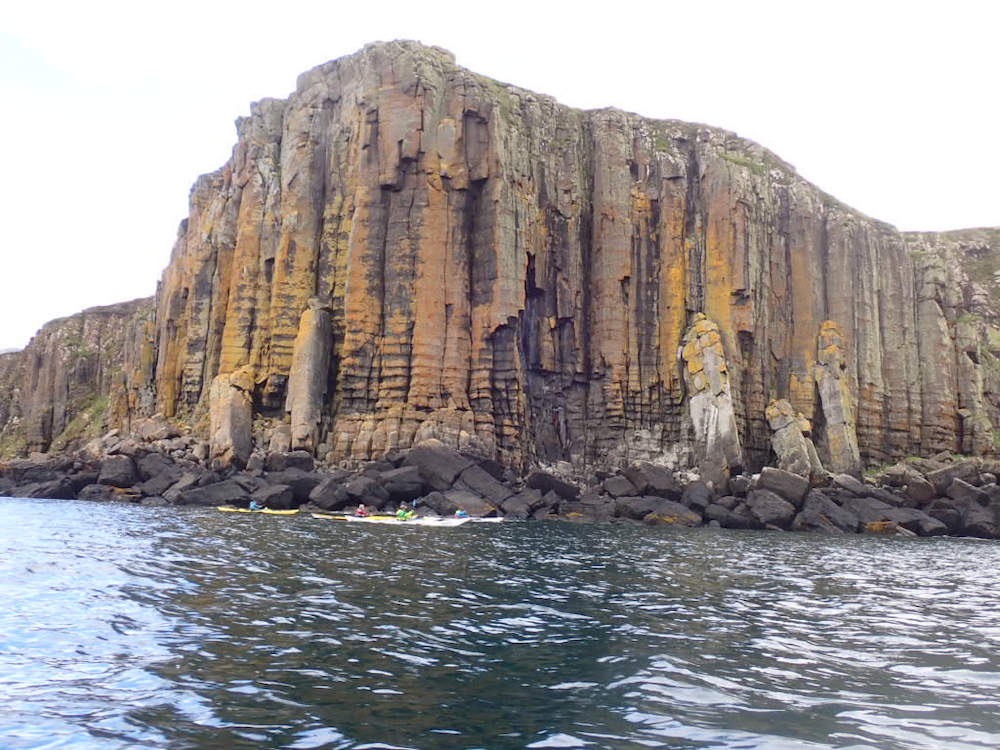
As I made final decisions for the location for a 5-6 day guided sea kayak expedition on the west coast of Scotland, the windy westerly airstream was maintaining its grip on the Scottish summer. The clients were packed and raring to go, so I weighed up all the variables: wind, temperature, camping spots, previous trips, and opted for Skye… never known to disappoint as a sea kayaking destination. The forecast promised a couple of windy days then improving.
After an evening of takeaway fish and chips, group introductions and looking at maps and kit, our journey started the next morning in Broadford. The first day of kayak packing was efficient and we launched into some ominous strong westerly gusts coming over the land. After about an hour we stopped and it became clear to me that the planned camping spot wasn’t going to be possible with gusts of over 30 knots starting to make boat handing challenging. I was quickly onto plan C, then soon after, it was Plan D!! They say that’s what plans are for!
We set up camp and double-pegged our tents, gathered wood for the bonfire, cooked marshmallows, drank whisky and took bets on whether our tents would last the night in the 38 knot gusts.
The day dawned and thankfully we were all intact, so we packed up and paddled over to Raasay and continued northwards up the east coast of Raasay, pushed along by strong but abated westerly winds. A longish day of nearly 30km, passed quickly with the magnificent coastlines and vibrant colours. A beautiful waterfall graced our first lunch stop and the geology morphed from sandstone to Lewisian Gneiss. A lovely wild camp on Raasay was welcome and the group settled into an “exped routine”.
A relaxed start to day three meant some time for swimming in the sheltered bay and allowed time for the winds to drop further, but it was a long awkward carry to launch the kayaks in the early afternoon. A lovely paddle to the north tip of Rona to find water which we did water from a tap at the seemingly abandoned military base. The winds were still strong so returned the same way back to camp.
Finally the wind dropped on day four, and we made the crossing to Skye in almost perfect conditions, and at 8km it was the longest most of the group had done. The journey provided an ever changing coastline as we ventured north. I chose to pass a couple of potential camping spots and it was a wearying group that paddled the last few kms into a slight headwind to reach Staffin island. Maybe the tired one was me! Once replenished with some hot food, more firewood was gathered and soon a beach bonfire was roaring away. More whisky and marshmallows were on the evening menu.
The final day was a surprising delight. I’d paddled this coastline once previously and from a distance due to the swell and sea state. On this occasion, with only a half metre north-westerly swell, the conditions were small enough to allow closer examination of the nooks and crannies but also some playful waves. After the wonderful basalt columns on Eilean Flodigarry which is a Kilt Rock in miniature, we explored the rocks and caves and stacks leading us northwards. This section deserves a full day exploring and I’ll be back. Rounding the Rubhas of the north-east corner of Skye (Rubha Bheanachain and Rubha na h-Aiseig), the tide was rushing north and west between us and Eilean Trodday, so we just poked our bows round and looked toward the Outer Hebrides, and the Shiant islands. The greater potential of what this area offers was laid out in front of us.
We retreated and headed towards Port Gobhlaig for second lunch stop and the end of our trip. We welcomed the channel at low water Springs which was cleared of rocks, although full of rotting stinking seaweed and carried our kayaks and kits in the sunshine and awaited the trailer pickup – thanks Kate!!

















If you have any paddling ambitions that you’d like to discuss with me, please use this form.
